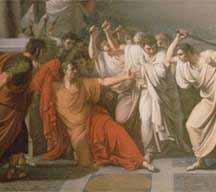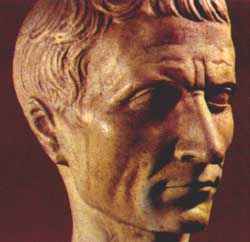Constitutional problems
 Caesar's most important problem, however, was that he was too powerful: the Roman Republic was an oligarchy in which the powers were shared among the senators. Even though the Senate was defeated, oligarchic sentiments were strong, and Caesar had to find a way to make his rule tolerable. His clemency was important, but nothing more than a precondition to this.
Caesar's most important problem, however, was that he was too powerful: the Roman Republic was an oligarchy in which the powers were shared among the senators. Even though the Senate was defeated, oligarchic sentiments were strong, and Caesar had to find a way to make his rule tolerable. His clemency was important, but nothing more than a precondition to this.
It is possible that Caesar wanted to evade the question by leaving Rome and starting a new military campaign. In the spring of 44, an expeditionary force was on its way to the east, where Crassus's death had to be avenged. Its temporary commander was the son of Caesar's niece Atia, the young Caius Octavius. Caesar was to follow his legions and planned to attack the Parthians. Of course, success in the east would not have solved the problem.
Another way was to behave himself as a king, without actually using this title. The only kings the Romans knew, were the oriental kings, and therefore Caesar used their symbols to show his power. His statue was placed among those of the legendary Roman kings, he was allowed to wear a purple robe, he was given the surname Father of the Country, sat on a raised couch in the theatre and on a golden throne in the Senate, coins showed his portrait, and a temple was erected to Caesar's Clemency: its first priest was Marc Antony. When people wanted to approach him, he received them without rising. On the other hand, he refused to wear a crown, but was satisfied with a laurel wreath to cover his bald head.
Roman constitutional law allowed one way to exercise personal rule: the dictatorship. Caesar was made dictator after his return from Ilerda; in October 48 he was again appointed, in 46 he became dictator for ten years and in 44 for life. This was, however, not a solution, since the dictatorship had already been misused by Sulla, and even though it was a legal construction, it smelled like blood. A permanent consulship seemed to be a better response to the situation, and indeed, Caesar had himself elected consul in 48, 46, 45 and 44 (with Marc Antony). He also experimented with Pompey's innovation, the consulship without colleague (45). Again, this didn't work: although repeated consulships were not unconstitutional, occupying a magistrature permanently made it impossible for the aristocrats to show their importance. And indeed, many people's feelings were hurt. In the last weeks before his death, Caesar seems to have found a solution: he accepted the powers of several magistratures without occupying the magistratures themselves. In this way, Caesar could control the government without interfering with the careers of the nobles. The settlement by the emperor Augustus in 27 BCE shows that this solution could have been acceptable.
However, many Roman senators refused to resign themselves to a controlled oligarchy. More than sixty joined the conspiracy led by Caius Cassius and Marcus Brutus. They decided to kill the dictator when the Senate would meet on March 15.
On this day, Caesar was ill, and he decided to stay at home with his wife Calpurnia, who was discomforted because of some nightmares. Brutus' brother Decimus Brutus, however, visited the couple and implored Caesar not to disappoint the waiting senators. On his way to Pompey's theatre, several people handed over requests: Caesar held them in his left hand, intending to read them after the meeting. Accordingly he did not read a notice revealing the plot.
As he sat down on his raised couch and had received the senators who had gathered about him to pay their respects, Lucius Tillius Cimber came forward to make a request. He told Caesar that his brother was in jail and when Caesar started to reply that clemency was his usual policy, Tillius unexpectedly caught Caesar's toga.
"Be careful, there's no need to use force!", Caesar grumbled and asked his guard to take away the man. However, before the guard could interfere, another senator, Casca, stabbed the dictator just below the throat. Then, his victim understood what was happening, and he caught Casca's arm and run through it with the only weapon he could find, his pen. As Caesar tried to leap on his feet, he was kicked and stopped by another wound. When Caesar saw that he was surrounded by men with daggers, he knew he would not survive. He wrapped his head in his robe and covered the lower part of his body with a part of his toga, and was stabbed with twenty three wounds, not uttering a word.
All the conspirators made off, and Caesar lay lifeless at the feet of a statue of Pompey. For hours, nobody dared to come close, until three common slaves put his corpse on a litter and carried him home, with one arm hanging down.


|









